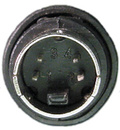In composite video, the luminance signal is low-pass filtered to prevent crosstalk between high-frequency luminance information and the color subcarrier. In S-Video Color and Luminance signals are separated in cable, so low-pass filtering isn't needed. This increases bandwidth for the luminance information, subdues the color crosstalk problem and leaves more video information intact, thus having a improved image reproduction compared to composite video.
Due to the separation of the video into brightness and colour components, S-Video is sometimes considered a type of component video signal, although it is also the most inferior of them, quality-wise, being far surpassed by the more complex component video schemes (like RGB). What differentiates S-Video from these higher component video schemes is that S-Video carries the colour information as one signal. This means that the colours have to be encoded in some way, and as such NTSC, PAL and SECAM signals are all decidedly different through S-Video. Thus, for full compatibility the used devices not only have to be S-Video compatible but also compatible in terms of colour encoding.
| Pin | Name | Description |
|---|---|---|
| 1 | GND | Ground (Y) |
| 2 | GND | Ground (C) |
| 3 | Y | Intensity (Luma) |
| 4 | C | Color (Chroma) |
The luma (Y; greyscale and blanking/sync) signal and modulated chroma (C; colour) information are carried on separate synchronized signal/ground pairs.
S-Video signals are generally connected using 4-pin mini-DIN connectors using a 75 ohm termination impedance. Today, S-Video can be transferred through SCART connections as well. S-Video and RGB are mutually exclusive through SCART, due to the S-Video implementation using the pins allocated for RGB. Most SCART-equipped televisions or VCRs (and almost all of the older ones) do not actually support S-Video, resulting in a black-and-white picture if attempted to use, as only the luminance signal portion is used. Black-and-white picture in itself can also be a sign of incompatible colour encoding, for example NTSC material viewed through a PAL-only device.
A hack exists to possibly attain color on devices that do not support S-Video through SCART. This is done via joining the pins 15 and 20 in the SCART connector (either directly or using a 470pF capacitor), and may not yield optimal results.
It is very simple to convert S-Video to composite signal (just the logical merging of the two through a filter is required) or vice versa.





 правильная
правильная с ошибками
с ошибками